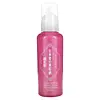What's inside
What's inside
 Key Ingredients
Key Ingredients

 Benefits
Benefits

 Concerns
Concerns

No concerns
 Ingredients Side-by-side
Ingredients Side-by-side

Sodium Hyaluronate
HumectantHydrolyzed Hyaluronic Acid
HumectantWater
Skin ConditioningGlycerin
HumectantDipropylene Glycol
HumectantTranexamic Acid
AstringentButylene Glycol
HumectantDiglycerin
HumectantPEG-8
HumectantPEG-6
HumectantPEG-32
HumectantStyrene/Vp Copolymer
Polysorbate 20
EmulsifyingHydroxylated Lecithin
EmulsifyingCitric Acid
BufferingTocopherol
AntioxidantMagnesium Ascorbyl Phosphate
AntioxidantPentylene Glycol
Skin ConditioningPhenoxyethanol
PreservativeDipotassium Glycyrrhizate
HumectantDisodium EDTA
Sodium Hyaluronate, Hydrolyzed Hyaluronic Acid, Water, Glycerin, Dipropylene Glycol, Tranexamic Acid, Butylene Glycol, Diglycerin, PEG-8, PEG-6, PEG-32, Styrene/Vp Copolymer, Polysorbate 20, Hydroxylated Lecithin, Citric Acid, Tocopherol, Magnesium Ascorbyl Phosphate, Pentylene Glycol, Phenoxyethanol, Dipotassium Glycyrrhizate, Disodium EDTA
Water
Skin ConditioningButylene Glycol
HumectantGlycosyl Trehalose
Emulsion StabilisingHydrogenated Starch Hydrolysate
HumectantRice Ferment Filtrate
Skin ConditioningGlutamic Acid
HumectantArginine
MaskingGlycine
BufferingAspartic Acid
MaskingSerine
MaskingValine
MaskingProline
Skin ConditioningIsoleucine
Skin ConditioningThreonine
Histidine
HumectantAlanine
MaskingPhenylalanine
MaskingCeramide EOP
Skin ConditioningCeramide NP
Skin ConditioningCeramide AP
Skin ConditioningAscorbyl Glucoside
AntioxidantMagnesium Ascorbyl Phosphate
AntioxidantPlacental Protein
HumectantArbutin
AntioxidantDipotassium Glycyrrhizate
HumectantBetaine
HumectantSqualane
EmollientTriethylhexanoin
MaskingIsostearic Acid
CleansingPhytosteryl/Octyldodecyl Lauroyl Glutamate
Skin ConditioningCholesterol
EmollientPhytosphingosine
Skin ConditioningSodium Lactate
BufferingPCA
HumectantSodium PCA
HumectantSodium Lauroyl Lactylate
EmulsifyingPolysorbate 60
EmulsifyingPolysorbate 20
EmulsifyingPEG-60 Hydrogenated Castor Oil
EmulsifyingCarbomer
Emulsion StabilisingXanthan Gum
EmulsifyingAcrylates/C10-30 Alkyl Acrylate Crosspolymer
Emulsion StabilisingHydroxyethyl Acrylate/Sodium Acryloyldimethyl Taurate Copolymer
Emulsion StabilisingDisodium EDTA
Potassium Hydroxide
BufferingEthylhexylglycerin
Skin ConditioningGlyceryl Caprylate
EmollientPhenoxyethanol
PreservativeParfum
MaskingWater, Butylene Glycol, Glycosyl Trehalose, Hydrogenated Starch Hydrolysate, Rice Ferment Filtrate, Glutamic Acid, Arginine, Glycine, Aspartic Acid, Serine, Valine, Proline, Isoleucine, Threonine, Histidine, Alanine, Phenylalanine, Ceramide EOP, Ceramide NP, Ceramide AP, Ascorbyl Glucoside, Magnesium Ascorbyl Phosphate, Placental Protein, Arbutin, Dipotassium Glycyrrhizate, Betaine, Squalane, Triethylhexanoin, Isostearic Acid, Phytosteryl/Octyldodecyl Lauroyl Glutamate, Cholesterol, Phytosphingosine, Sodium Lactate, PCA, Sodium PCA, Sodium Lauroyl Lactylate, Polysorbate 60, Polysorbate 20, PEG-60 Hydrogenated Castor Oil, Carbomer, Xanthan Gum, Acrylates/C10-30 Alkyl Acrylate Crosspolymer, Hydroxyethyl Acrylate/Sodium Acryloyldimethyl Taurate Copolymer, Disodium EDTA, Potassium Hydroxide, Ethylhexylglycerin, Glyceryl Caprylate, Phenoxyethanol, Parfum
 Reviews
Reviews

Ingredients Explained
These ingredients are found in both products.
Ingredients higher up in an ingredient list are typically present in a larger amount.
Butylene Glycol (or BG) is used within cosmetic products for a few different reasons:
Overall, Butylene Glycol is a safe and well-rounded ingredient that works well with other ingredients.
Though this ingredient works well with most skin types, some people with sensitive skin may experience a reaction such as allergic rashes, closed comedones, or itchiness.
Learn more about Butylene GlycolDipotassium Glycyrrhizate comes from licorice root.
Extracts of licorice have demonstrated to have antibacterial, anti‐inflammatory, antiviral, antioxidant properties.
One component, glabridin, has extra potent antioxidant and soothing properties. It has also been found to block pigmentation from UVB rays in guinea pigs.
Licorice Root also contains a flavonoid. Flavonoids are a natural substance from in plants. Flavonoids also have antioxidant properties.
Another component, glycyrrhizin, has been found to have anti-inflammatory and antimicrobial benefits. This may make licorice root extract effective at treating acne. However, more research is needed to support this.
Liquiritin is one of the flavone compounds found in licorice. It has been found to help lighten skin by preventing tyrosinase from reacting with tyrosine. When the two react, protein is converted to melanin. Melanin is the substance in your body that gives your features pigmentation.
Licorice root is native to Southern Europe and Asia. It has been used in traditional Chinese medicine to help with respiratory issues.
Learn more about Dipotassium GlycyrrhizateDisodium EDTA plays a role in making products more stable by aiding other preservatives.
It is a chelating agent, meaning it neutralizes metal ions that may be found in a product.
Disodium EDTA is a salt of edetic acid and is found to be safe in cosmetic ingredients.
Learn more about Disodium EDTAMagnesium Ascorbyl Phosphate (MAP) is a form of Vitamin C and is an antioxidant. It can help to reduce redness, improve skin texture, reduce the effects of aging, reduce the visibility of dark spots, and brighten skin.
MAP is created by combining ascorbic acid with magnesium salt. While MAP more gentle on the skin than ascorbic acid, it is thought to be less easily-absorbed into the skin.
Due to MAP's stability up to a pH level of 7, it is more stable to air and sunlight exposure than ascorbic acid. The best pH range for MAP is between 5 and 6.
Like other forms of Vitamin C, MAP has been shown to help reduce hyperpigmentation and simulate collagen production.
As an antioxidant, it helps protect your skin against the signs of aging.
Learn more about Magnesium Ascorbyl PhosphatePhenoxyethanol is a preservative that has germicide, antimicrobial, and aromatic properties. Studies show that phenoxyethanol can prevent microbial growth. By itself, it has a scent that is similar to that of a rose.
It's often used in formulations along with Caprylyl Glycol to preserve the shelf life of products.
Polysorbate 20 is made by combining ethoxylation of sorbitan, ethylene oxide, and lauric acid. It is a mild cleansing agent, surfactant, and emulsifier.
As a surfactant, it helps collect dirt and oils for washing. Emulsifiers prevent oils and water from separating.
Polysorbate 20 also adds scent to a product. Since it is made using sorbitol, it has a sweet scent. Sorbitol can also be found in fruits such as apples and peaches.
The lauric acid used to create Polysorbate 20 is often derived from coconuts.
Polysorbate 20 may not be fungal acne safe.
Learn more about Polysorbate 20Water. It's the most common cosmetic ingredient of all. You'll usually see it at the top of ingredient lists, meaning that it makes up the largest part of the product.
So why is it so popular? Water most often acts as a solvent - this means that it helps dissolve other ingredients into the formulation.
You'll also recognize water as that liquid we all need to stay alive. If you see this, drink a glass of water. Stay hydrated!
Learn more about Water